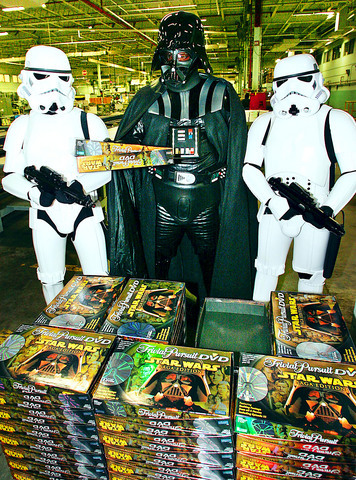There are no Best Picture Oscars on his mantel, but filmmaker George Lucas received an award last week at ShoWest 2005 that no one else will ever get.
"I've been here at ShoWest quite a bit over the last 30 years, but I never, ever expected to get the Galactic Achievement Award," Lucas said after receiving the accolade and enjoying the night's only prolonged standing ovation.
Closing night at ShoWest honored Mel Gibson with the Film of the Year award for The Passion of the Christ, and Matt Damon and Jennifer Aniston were named Stars of the Year -- along with several other performers. But the main attraction was Lucas, whose sixth and final Star Wars movie will hit theaters May 19.

PHOTO: REUTERS
Earlier in the day, Lucas had treated theater owners at the convention to an extended preview of Star Wars: Episode III -- Revenge of the Sith. The scenes featured the dramatic metamorphosis of hero Anakin Skywalker into villain Darth Vader.
Lucas said audiences should be prepared to bring tissues for the second half. "This film is more of a tear jerker," he told reporters prior to the awards dinner. "It works as an emotional tragedy."
Lucas spoke of plans to eventually re-release all six of his Star Wars movies in 3D format, something he believes that, along with digital technology, is the future of movies. He hopes to begin in 2007 with a 3D version of the original Star Wars. The plan would then be to re-release each subsequent film in 3D a year at a time. There are also plans for a DVD six-pack of all the movies at some point, but the format is still being determined, Lucas said.
Lucas insisted that there will never be episodes VII, VIII and IX of the franchise. "It was a figment of the media's imagination. I made a joke once, and it turned into three more films."
Lucas confessed to reporters that he is actually glad to be releasing his final Star Wars film into theaters.
"When I committed to episodes I, II and III, I knew that was a 10-year commitment that would be arduous. I'll be glad to get my life back. For me, that's very exciting."
As for the future, Lucas is waiting for a script for a new Indiana Jones movie and also wants to experiment with different kinds of filmmaking technology to make short films and even some television.
"I've worked very hard to earn the right to fail for the rest of my life."

On April 26, The Lancet published a letter from two doctors at Taichung-based China Medical University Hospital (CMUH) warning that “Taiwan’s Health Care System is on the Brink of Collapse.” The authors said that “Years of policy inaction and mismanagement of resources have led to the National Health Insurance system operating under unsustainable conditions.” The pushback was immediate. Errors in the paper were quickly identified and publicized, to discredit the authors (the hospital apologized). CNA reported that CMUH said the letter described Taiwan in 2021 as having 62 nurses per 10,000 people, when the correct number was 78 nurses per 10,000

As we live longer, our risk of cognitive impairment is increasing. How can we delay the onset of symptoms? Do we have to give up every indulgence or can small changes make a difference? We asked neurologists for tips on how to keep our brains healthy for life. TAKE CARE OF YOUR HEALTH “All of the sensible things that apply to bodily health apply to brain health,” says Suzanne O’Sullivan, a consultant in neurology at the National Hospital for Neurology and Neurosurgery in London, and the author of The Age of Diagnosis. “When you’re 20, you can get away with absolute

May 5 to May 11 What started out as friction between Taiwanese students at Taichung First High School and a Japanese head cook escalated dramatically over the first two weeks of May 1927. It began on April 30 when the cook’s wife knew that lotus starch used in that night’s dinner had rat feces in it, but failed to inform staff until the meal was already prepared. The students believed that her silence was intentional, and filed a complaint. The school’s Japanese administrators sided with the cook’s family, dismissing the students as troublemakers and clamping down on their freedoms — with

As Donald Trump’s executive order in March led to the shuttering of Voice of America (VOA) — the global broadcaster whose roots date back to the fight against Nazi propaganda — he quickly attracted support from figures not used to aligning themselves with any US administration. Trump had ordered the US Agency for Global Media, the federal agency that funds VOA and other groups promoting independent journalism overseas, to be “eliminated to the maximum extent consistent with applicable law.” The decision suddenly halted programming in 49 languages to more than 425 million people. In Moscow, Margarita Simonyan, the hardline editor-in-chief of the